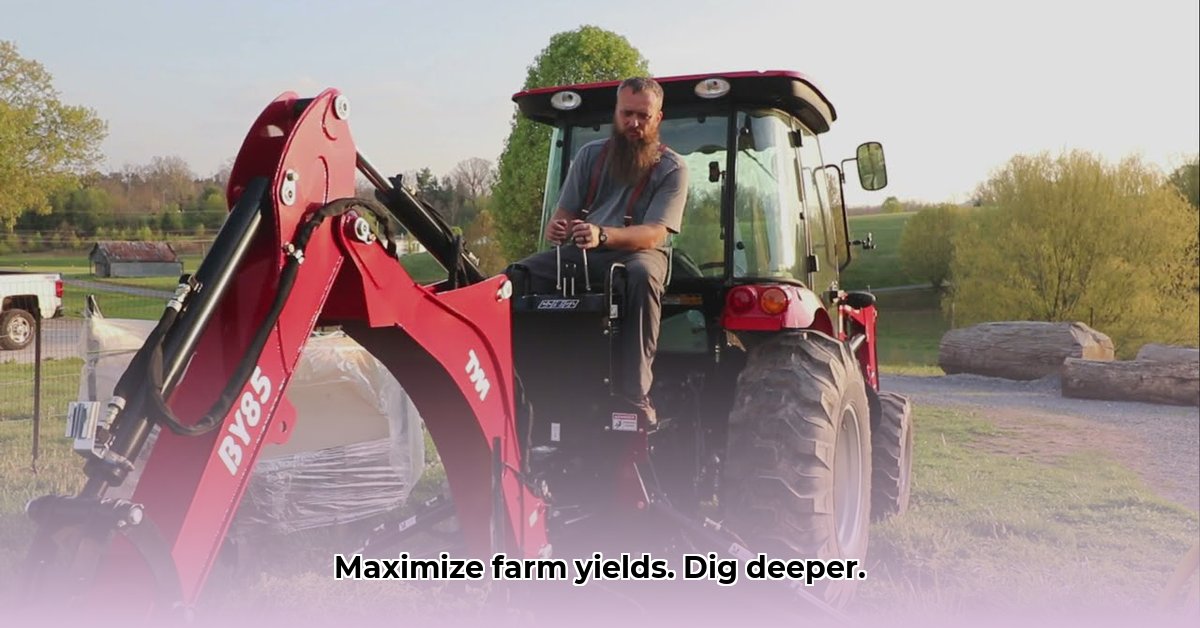
Choosing the right tractor-mounted post hole digger can significantly boost your farm's efficiency. This guide provides actionable advice on selecting and using this essential piece of equipment, focusing on compatibility, auger bit selection, gearbox considerations, and safety. The increasing popularity of American-made diggers is also highlighted. For more information on tractor selection, see our guide on tractor buying.
Understanding Tractor Compatibility: Ensuring a Perfect Fit
Before selecting a post hole digger, verify its compatibility with your tractor. This involves checking three key aspects: horsepower, power take-off (PTO) shaft, and three-point hitch.
Horsepower (HP): Your tractor must provide sufficient HP to power the digger. Consult your tractor's manual for its HP rating and the digger manufacturer's specifications for minimum HP requirements. Insufficient HP leads to inefficient operation and potential equipment damage.
PTO (Power Take-Off) Shaft: The PTO shaft transmits power from your tractor to the digger. Ensure your tractor's PTO is compatible with the digger's requirements regarding size and RPM (revolutions per minute). Incorrect RPM can damage the equipment or render it ineffective.
Three-Point Hitch: This system connects the digger to your tractor. Ensure that your tractor's three-point hitch category (I, II, or III) matches the digger's requirements for a secure and stable connection, preventing accidents and ensuring proper functionality.
| Tractor HP Range | Recommended Digger Category | Notes |
|---|---|---|
| 20-40 | I | Suitable for smaller properties and lighter-duty applications. |
| 40-60 | II | Ideal for moderate-sized farms and a variety of tasks. |
| 60+ | III | Best for large properties and heavy-duty applications. |
Always consult the manufacturer's specifications for both your tractor and the post hole digger.
Auger Bit Selection: The Right Tool for Every Job
The auger bit is the digging component of the post hole digger. Choosing the right bit is crucial for efficiency.
Size: The bit's diameter determines the hole size. Select a size appropriate for your application (e.g., fence posts, tree planting).
Material: Hardened steel bits are more durable, particularly in tough soil conditions. Softer materials might be suitable for easier digging but will wear out faster.
Point Style: The point's shape and sharpness affect how easily it cuts through the soil. Sharper points are ideal for harder soils.
This table illustrates auger bit types:
| Auger Bit Type | Soil Type | Application Examples |
|---|---|---|
| Standard Auger Bit | Most soil types | Fencing, small tree planting |
| Rock Auger Bit | Rocky, hard soils | Fencing in rocky areas |
| Earth Auger Bit | Loose, soft soils | Tree planting, larger holes |
Gearbox Considerations: Optimizing Digging Performance
The gearbox controls the auger's speed and torque.
Hard Soil: Slower speeds and higher torque are needed for hard or compacted soils to break through resistance more effectively.
Soft Soil: A faster speed might be more suitable for soft soils to increase efficiency without sacrificing effectiveness.
The gearbox allows you to tailor the auger's performance to different soil types and applications. A variable-speed gearbox adds versatility.
Top Models and Manufacturers: A Market Overview
Numerous manufacturers produce tractor-mounted post hole diggers. Everything Attachments 1 is a reputable example, known for quality and durability. Thoroughly research different models, focusing on specifications and reading reviews from other users to ensure that the chosen model suits your needs.
Safe Operating Procedures: Prioritizing Safety
Always prioritize safety when operating PTO-driven equipment.
- Proper Training: Obtain thorough training on operation and safety procedures before use.
- Clear the Area: Remove any obstructions from the area before starting.
- Hearing Protection: Wear hearing protection due to high noise levels.
- Safe Distance: Maintain a safe distance from the rotating auger. Never reach into the auger while it is running.
Maintenance and Troubleshooting: Ensuring Longevity
Regular maintenance is crucial for the digger's longevity and safe operation.
- Regular Inspections: Regularly check for wear and tear.
- Lubrication: Keep all moving parts well-lubricated.
- Sharpening: Sharpen auger bits as needed to maintain efficiency.
- Troubleshooting: Address any issues promptly to prevent major problems.
Conclusion: Maximizing Your Investment
Choosing the right tractor-mounted post hole digger requires careful consideration of tractor compatibility, auger bit selection, gearbox capabilities, and safety procedures. By following this guide, you can maximize efficiency and longevity. Remember to consult local equipment dealers or manufacturers for personalized guidance.